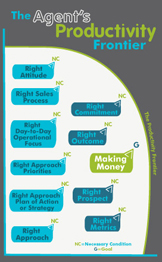The Necessary Conditions to Achieve Personal Selling Success
By Charles Fifield, Senior Lecturer and Baylor Sales Coach
Being an agent and having a career involving personal selling is essentially a for-profit business enterprise. Therefore, the basic goal of personal selling is to make money, net of expenses, and preferably at a growing or incrementally productive rate. To do so, there are four key drivers to being successful in that quest. First, an agent must focus on increasing throughput or the flow of contracts. Second, an agent's "inventory" or "work in progress" is their investment in future throughput and an agent's average number of required-interactions-per-client-contract-gained should be declining. Third, the agent must strive to reduce the operating expenses per client contract gained, which is what the agent expends to convert an inventory of prospects into future throughput. And fourth, an agent must seek to reduce the average cycle time it takes to complete the sales process and transform their prospects into satisfied client contracts. In order to incrementally improve an agent's productivity and bottom line, the agent needs to focus change efforts on those "primary" constraints that, if modified, would have the greatest positive impact on the desired outcome. To analyze the changes which would produce the greatest positive money-making impact, there are diagnostic tools such as learning trees with their inherent undesirable effect linkages or fishbone diagrams. These tools enable the agent to locate root problems or the primary constraints which are causing the underperformance effect. Constraints take essentially three forms - policy (what may be termed "stinking thinking"), process (prospect conversion or contract management issues) or people (the wrong people "on your bus"). Constraints will most often be found in what are the ten necessary or right conditions for achieving personal selling success. Over the next several issues of the Keller Center Research Report, we will explore these ten rights in some detail. The relationship between the necessary conditions that define an agent's productivity potential or frontier and the goal of making money are illustrated.

To incrementally advance one's productivity requires improving one or more of the ten right condition vectors.
- Right Condition #1 - The Right Attitude: Highly effective personal selling begins and ends with the right agent attitude.
- Right Condition #2 - The Right Sales Process: The selling process is a step-by-step sequential client-driven cycle of operations and inertia must avoided.
- Right Condition #3 - The Right Day-To-Day Operational Focus: Successful agents must seek to simultaneously avoid waste, which is any activity that doesn't add value to their client, while increasing the time spent in face-to-face prospective buyer-seller interactions.
- Right Condition #4 - The Right Prospect: One of the biggest productivity downfalls for agents is their seeing the wrong or unqualified prospects.
- Right Condition #5 - The Right Approach Priorities: Personal selling is largely a two-fold process of selling first yourself (the relationship dynamic) and then discovering and defining the buyer's "eager wants" to determine a possible match to your capabilities (the value dynamic).
- Right Condition #6 - The Right Approach Plan of Action or Strategy: Highly effective agents tend to follow a systematic format or flow in delivering their interactive sales presentations.
- Right Condition #7 - The Right Approach: To maintain consistency during interactions, highly effective agents tend to follow a sequential order of steps or phases to their personal selling interactions.
- Right Condition #8 - The Right Outcome: From beginning to end, win-win thinking must be promoted by the agent in the buyer-seller relationship.
- Right Condition #9 - The Right Metrics: You cannot manage what you fail to effectively measure and a holistic view of all stakeholders to the client relationship must be considered.
- Right Condition #10 - The Right Commitment: Think Long-term, for in the end, client or customer loyalty is the goal.
. . . . . . . . . . . . . . . . . . .
About The Author
Charles Fifield, MBA
Senior Lecturer and Baylor Sales Coach, Baylor University
Chuck Fifield is a Senior Lecturer for Baylor University's Hankamer School of Business, Marketing Department - Professional Sales and Communications and serves as the faculty consultant to Baylor's Sales Team and Uproar Music and Entertainment Group, a student managed business. He joined the faculty at Baylor University in 2001, where he has also taught in the Graduate Business School (Operations Management), the Management Department (Negotiations and Conflict Resolution) and the Economics Department (Principles of Macroeconomics). Chuck has taught or guest lectured at other Texas-based Universities in the fields of sales, international business, money and banking and finance/investments. Professor Fifield has conducted sales research and training for several organizations, including most recently State Farm Insurance. Prior to joining Baylor, Chuck was a financial consultant to businesses located throughout the U.S. for nearly thirty years. He owned and operated several financial service businesses in the fields of securities, real estate, oil and gas and insurance.